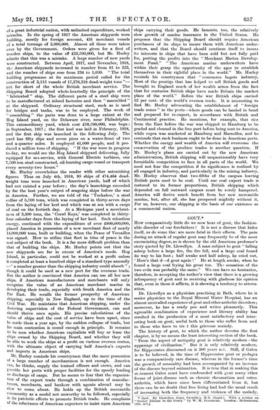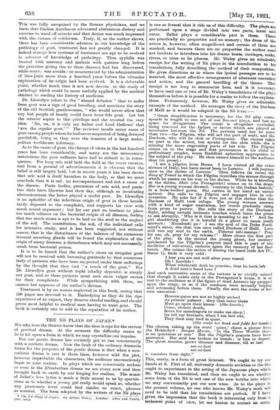GOUT.*
How comparatively little do we now hear of gout, the fashion- able disorder of our forefathers ! It is not a disease that hides itself, as do some that are more fatal in their effects. The pain during an attack of regular gout may frequently be of the most excruciating degree, as is shown by the old American professor's story quoted by Dr. Llewellyn. A man subject to gout " falling asleep before a large fire, the fire fell, and a large coal found its way to his foot ; half awake and half asleep, he cried but, ' Here's that d—d gout again ' He at length awoke, when he found a large coal frying his great toe. Th3 sensation of the two evils was probably the same." We can have no hesitation, therefore, in accepting the author's view that there is a growing infrequency of gout and in receiving with gladness his opinion that, even in those it afflicts, it is showing a tendency to attenu- ation.
Dr. Llewellyn as a physician practising in Bath, where he is senior physician to the Royal Mineral Water Hospital, has an almost unrivalled experience of gout and other arthritic disorders ; moreover, he has a ready pen and writes pleasantly. This agreeable combination of experience and literary ability has resulted in the production of a most satisfactory and inter- esting book on gout, useful both to those who suffer from and to those who have to tre t this grievous malady.
The history of gout, to which the author devotes the first chapter, is by no means the least interesting section of the book. " From the aspect of antiquity gout is relatively modern—the appanage of civilization." But it is only relatively modern, for Hippocrates discoursed on it 300 years B.C. Still, if Galen is to be believed, in the time of Hippocrates gout or podagra was a comparatively rare disease, whereas in the former's time the growth of sensuality had been accompanied by an increase of the disease beyond estimation. It is true that in making this statement Galen must have confounded with gout many other forms of joint-disease such as chronic rheumatism and osteo- arthritis, which have since been differentiated from it, but there can be no doubt that free living had had the usual result of increasing both the frequency and violence of the malady.
• Gout. By Llewellyn Jones Llewellyn. H.B. (Lend.). With a section on "Ocular Disease in the Gouty" by W. AL Beaumont. London : Heinemann. (303. nct.1
This was fully recognized by the Roman physicians, and we learn that Caelius Aurelianus advocated abstemious dietary and exercise to ward off attacks and that Aetius was much impressed
with the virtues of colchicum. Truly, if, as the author shows, there has been considerable advance in our knowledge of the pathology of gout, treatment has not greatly changed. It is
indeed strange how systems of treatment are apt to be evolved in advance of knowledge of pathology. Thus syphilis was treated with mercury and malaria with quinine long before the parasites giving rise to these diseases had bee discovered, while scurvy was avoids i or counteracted by the administration of lime-juice more than a hundred years before the vitamine explanation of its origin had been evolved. It is a debatable point, whether much time is not now devote to the study of pathology which could be more usefully applied by the medical student to reading the history of medicine.
Dr. Llewellyn refers to the " absurd delusion " that to suffer from gout was a sign of good breeding, and mentions the story of the old Scottish gentlewoman, " who would never allow that any but people of family could have bona-fide gout. Let but the roturier aspire to this privilege and she scouted the very idea. Na, na, it is only my father and Lord Gallows' that have the regular gout.' " The reviewer recalls many cases of gout among people whom he had never suspected of being decayed gentlefolk, being as they were the inmates of a large metro- politan workhouse infirmary.
As to the cause of gout, the change of views in the last hundred years has been considerable, and many are the unnecessary restrictions the poor sufferers have had to submit to in conse- quence. For long uric acid held the field as the cause caimans, and from a perusal of advertisements it is obvious that the belief is still largely held, but in recent years it has been shown that uric acid is itself harmless to the body, so that we must conclude that it is onl an accompaniment and not a cause of the disease. Purin bodies, precursors of uric acid, and purin- free diets have likewise had their day, although as inculcating abstemiousness the latter played a useful part. Dr. Llewellyn is an upholder of the infectious origin of gout in those heredi- tarily disposed to the complaint, and supports his view with much sound argument ; but for our part we hesitate to place too much reliance on the bacterial origin of all diseases, feeling that too much stress is apt to be laid on the seed to the neglect of the soil. The constitution, the soil, of the individual calls for intensive study, and it has been suggested, not without reason, that in the disturbance of the balance of the numerous internal secreting glands will be found the explanation of the origin of many diseases, a disturbance which may not necessarily result from bacterial poison.
It is to be feared that the author's views on irregular gout will not be received with becoming gratitude by that numerous body of patients who have been supported under their sufferings by the thought that they had " a touch of the gout." For Dr. Llewellyn gout without tophi (chalky deposits) is simply not gout, and so these patients must seek more vulgar names for their complaints. While sympathizing with them, we cannot but approve of the author's dictum.
Treatment is by no means neglected in this book, seeing that 130 pages are devoted to it. Embodying as they do the ripe experience of an expert, they deserve careful reading, and should prove meat helpful to medical men having to treat gout. The book is certainly one to add to the reputation of its author.



































 Previous page
Previous page